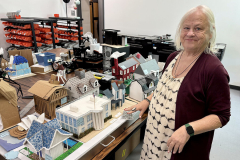To get U.S. students back in class, educators have tried everything. They’ve visited homes, improved bus routes, increased mentoring, and even dangled cash rewards.
Enter the Nintendo Switch. Eports classes are an example of another tactic schools are deploying in a bid to reduce chronic absenteeism. They’re offering unique courses or programs that engage students.
“The way to get kids to show up isn’t going to be through social studies,” says Robert Fusato, who teaches esports and ukulele classes at Maui Waena Intermediate School in Hawaii. “If we can hook them through things they’re interested in – and they can build confidence and become skilled at something – they’ll hang around for the other things.”
Why We Wrote This
As schools combat chronic absenteeism, one solution gaining traction is offering elective courses that are too interesting to skip. The result is a better attitude toward school – and toward the rest of the subjects in it.
For the past few years, educators across the nation have been searching for ways to boost student attendance. Chronic absenteeism – generally defined as a student missing 10% or more of the school year – surged during the pandemic. Nearly 1 in 3 students fit that description. Since then, the percentage of chronically absent students has gradually fallen in most places after intentional reduction strategies. But the work is unfinished, and tapping into students’ interest appears to help.
Experts say doing so can breed motivation and provide a greater sense of belonging, both of which make school a place students want to be.
“One of the things [schools] can definitely do is simply attend to their core functions,” says Thomas Dee, a professor in Stanford University’s Graduate School of Education, who has studied chronic absenteeism. “Offering high-quality, engaging courses encourages students to show up – gives them a reason to post up in the classroom.”
That’s exactly how the esports class came to be at Maui Waena Intermediate School. A boy in the popular esports club quipped that he was only showing up to school because of afternoon matches. That student’s offhand remark correlated with his attendance record, Mr. Fusato says. That sparked the idea of upgrading the club to an elective course several years ago. Since then, school leaders say it has provided academic dividends that extend beyond students’ competitive gaming skills.
The 1,030-student school has seen attendance trending in a positive direction since the 2020-2021 academic year, when 32% of students were chronically absent. Last year, that rate fell to 22%. Are the unique elective courses helping? Principal Jacquelyn McCandless believes so.
“Even if it’s just for a fraction of kids, they all make a difference in my book,” she says.

Jackie Valley/The Christian Science Monitor
Jair Alba (left) and Ozzie Patton, both juniors at Northeast Career and Technical Academy, say they rarely miss a day of school given courses that align with their career interests.
Several thousand miles away, student-made models representing different architectural styles line a table in a North Las Vegas high school. There’s a Victorian home, a contemporary Sydney Opera House, and a White House replica showcasing federal design.
The project keeps students like Jair Alba, a junior at Northeast Career and Technical Academy, locked in on school. The teen says he rarely misses a d




